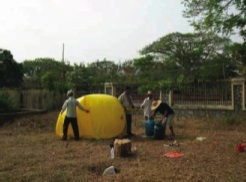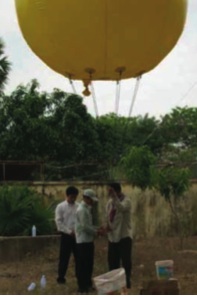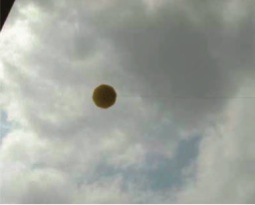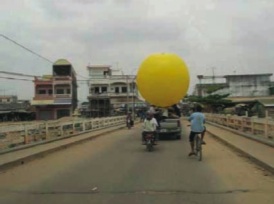|
The Department of Land Management and the Department of Urban Planning in Kampong Speu Province in Cambodia was in need for an actual aerial photo for their urban land use planning project. The available black and white aerial photos from 1992 were too old for planning in a fast developing urban area. Mr Teng Peng Seang from “Phnom Penh Geoinformatics Education Center” developed a technique to take aerial photos by using a balloon. Ded (German Development Service) provided the budget to test this technique for the use in urban planning activities in Cambodia. The result was an georeferenced aerialphoto with a resolution of 0,5 m. On the coloured photo, land use patterns were easy to identify; small huts, single trees, walls and fences were clearly visible.
Step 1: Preparation of the Balloon
The filling up of the balloon with Hydrogene Gas in the garden of the Provincial Department of Land Management Kompong Speu.
Photo 1: Inflating the balloon takes about 3 hours

Photo 2: 6 control strings hold the balloon in position

The filling procedure needed at least three hours. Then the balloon is ready to start.
Step 2: Testing the Wind Speed and Direction
To verify the direction of the wind, a first test start has had been necessary, without the camera equipment. The balloon is controled with three ropes of 1500m length each.
Photo 3: The wind direction above is important to plan the survey

Photo 4: Transport of the Balloon through Kampong Speu Town

The wind direction in 1000m height is not necessarily the same as on the ground. In this case the verified wind direction made a change of the first launch location necessary to ensure the overlight of the project area.
|